100 years ago today – April 21, 1918
There is likely no fighter airplane better known in the world than that flown by “The Bloody Red Baron of Germany,” as the song “Snoopy and the Red Baron” has it. People who know nothing about airplanes know the all-red Fokker Triplane flown by Rittmeister Manfred von Richtofen. The overwhelming number of homebuilt triplane replicas for the past 50 years Have been painted red when finished.
Manfred Albrecht, Freiherr von Richthofen, was born on May 2, 1892 in the eastern German city of Breslau. His father, Major Albrecht von Richthofen, a minor a Prussian nobleman, was retired from the Army. At age 11, Manfred was sent to the military school at Wahlstatt, and then to the Royal Military Academy at Lichterfelde. At graduation in April 1911, he was commissioned in the 1st Regiment of Uhlans, Kaiser Alexander III, and was promoted to Leutnant in 1912.
After brief service in the trenches following the outbreak of a war in which cavalry had no role, von Richtofen became an aerial observer, flying on the Eastern Front. He met the famous Oswald Boelcke, who advised him to become a pilot. Surprisingly, the future Ace of Aces was not a natural pilot, taking a then-unheard-of 24 hours of dual instruction before he was judged capable of solo on October 10, 1915 - this at a time when a pilot might solo with as few as 3-4 hours of dual training. He returned to the Eastern Front and flew observation airplanes until the summer of 1916, when Boelcke - then traveling throughout the Army to recruit pilots for the squadron he had been appointed to lead - stopped by. Boelcke remembered the young ex-Uhlan and brought him along to form the original pilot contingent of Jasta 2.
Boelcke gave his pilots strict instruction in his theories of air fighting before taking them to the Somme Front in the fall of 1916. The Royal Flying Corps had ended the “Fokker Scourge” in the Spring of 1916 with the introduction of the deHavilland D.H.2 and the Royal Aircraft Factory's F.E.2 series, and had established air superiority over the Somme Front by the time the great battle broke out on July 1, 1916.
Boelcke's unit, the first to be completely equipped with the then-advanced Albatros D.I and D.II biplanes armed with two machine guns synchronized to fire through the prop, and armed with his knowledge of how a fighting unit should operate in the air, was about to change the air war. Entering combat in mid-September, the unit made its presence felt immediately. Richthofen scored on their first mission and within a month he had six victories, when the leader was killed in a mid-air collision with one of his own men. A month later, Richtofen entered the history books with the epic fight that ended with him shooting down Major Lanoe Hawker, V.C., the leading British ace.
Richtofen soon rose to command Jasta 2 and demonstrated himself Boelcke's star pupil. He came into his own as the leading ace of the German air force when he bettered his teacher's score during the fighting of “Bloody April,” in 1917. By this time he was painting his airplanes red, and he was known as “der Rote Kampfflieger” by the Germans, “Le Petit Rouge” by the French, and “The Red Baron” by the British.
In June 1917, Richthofen was named commander of Jagdgeschwader 1, which brought together four fighter squadrons under a single fighting command. The unit became known as “The Flying Circus” due to the fact that they were able to transfer from airfield to airfield across the German front opposing the British forces as needed, in the manner of a traveling circus. The RFC and RNAS called them “the circus” when the pilots followed their leader in painting their airplanes in bright colors, unlike the drab appearance of the Pups, Tripehounds, and Camels flown by the RFC and RNAS on the Flanders front. “JaGe Ein” achieved immediate success over Ypres during July, August and September 1917.
Richtofen himself was shot down and nearly killed in combat with an F.E.2d of 25 Squadron on August 21, 1917. His deep head wound never fully healed and was still seeping on occasion by the time he met his fate eight months later. The wound caused pain and long-lasting headaches, making him more morose and pensive.
Many who have looked at von Richtofen's career have written him off as a heartless Prussian killing machine, a view that was strengthened by his collection of silver victory cups for each of his aerial victories, which were displayed in his bedroom at home along with the Lewis gun taken from Hawker's crashed D.H.2. In truth, Richtofen was a serious student of war and tactics, who applied what he had learned as a hunter in the German forests as a youth to the aerial battles over the Somme. He took advantage of the weather, with the prevailing winds working against his enemies as they followed their offensive philosophy and took the war over the German lines. As with most successful aerial fighters from his day to the present, he learned to avoid the mythological “dog fight,” attacking opponents whose first inkling he was there was his bullets stitching their airplane. His realistic view of war is shown in his statement, “I think of this war as it really is, not as the people at home imagine, with a hoorah! and a roar. It is very serious, very grim.”
By 1918, von Richtofen's fame was such that the German leadership feared a crisis of morale among the armed forces if he were to be killed. When asked to join the General Staff, he declined, saying, “I do not want to be a high-decorated officer in a safe place and my men are in the dirty field and dying.”
March 21, 1918 saw the commencement of Operation Michael, the German offensive designed to knock the British and French out of the war before the Americans could make their presence felt. JaGe I, in company with the other two Jagdgeschwaders made an all-out attempt to overcome their British and French opponents, despite the fact that the 1918 Spring was rainy. In fact, during his final month of combat, the air forces were only able to fly on about half the days due to the weather. On April 20, von Richtofen, flying Fokker Dr.I 425/17, scored his final two victories, both Sopwith Camels. In two weeks, he was scheduled to go home on leave, and was exhausted enough to be looking forward to it.
Like Boelcke, von Richtofen was superstitious, and did not want to be photographed before a mission. Fifteen minutes before takeoff on April 21, 1918, he was photographed as he pulled on his new one-piece flying suit, just as Boelcke had been photographed before his final flight.
Thirty minutes before von Richtofen led five Fokker Triplanes of Jastas 2 and 4, along with a flight of Albatros D.Vs from Jasta 5, the “Green Tail Jasta” who had been temporarily assigned to the Baron's command, eight Sopwith Camels of 208 Squadron RAF - formerly No. 8 Naval Squadron prior to the founding of the Royal Air Force on April 1 - took off from Bertangles for patrol. At the same time, two R.E.8s also left Bertangles for a photo mission over the German lines.
After patrolling the lines for 30 minutes, Richtofen's formation was near Hamel when he spotted the two R.E.8s as they turned away from their photo runs to head for home. Four Triplanes - including one flown by newcomer Leutnant Wolfram von Richtofen, the Baron's nephew - attacked the “‘Arry Tate's”, whose gunners gave as good as they got, forcing the Germans to break off their attack.
At this moment, 208 Squadron's flight, led by Captain Arthur Roy Brown, arrived above the fight. Seeing the R.E.8s under attack, Brown led his flight - minus the “new boy,” Wilfred “Wop” May, a school friend of Brown's back in Canada, who had been ordered to steer clear of any fights on this, his first mission.
Seeing the Camels attack his Triplanes, von Richtofen led the Jasta 5 Green Tails into the fight. The wind that day favored the British on this part of the front, and in the swirling fight the Germans were blown toward the enemy lines.
May was attacked by Wolfram von Richtofen, and broke away, diving toward home. Manfred von Richtofen spotted the fleeing Camel and gave chase. This violated every rule of combat he had laid down as he descended to low altitude where he could be fired at from the ground, and chased his would-be 81st victim toward the British lines.
May saw the approaching nemesis and began darting from side to side as he dropped low over the lines, heading along the road from the village of Corbie to Bray. The Triplane's one big failing was its relative lack of speed, and von Richtofen was drawn into an extended chase as he slowly gained on May.
Roy Brown broke away from a fight with two Albatroses, saw the all-red triplane chasing his friend and dove to save him. The Australian troops below saw the Camel, chased by the red triplane, chased by a second Camel, as the airplanes roared over the Somme Valley, a few hundred feet overhead.
Ten years later, in “My Fight with Richthofen,” published in the Chicago Tribune on April 22, 1928, Brown was quote:
“I was in a perfect position above and behind. ... neither plane, (Richthofen or May) was aware of me ... I had dived until the red snout of my Camel pointed fair at his tail. My thumbs pressed the triggers. Bullets ripped into his elevator and tail planes. The flaming tracers showed me where they hit. A little short! Gently I pulled back on the stick. The nose of the Camel rose ever so slightly. Easy now, easy. The stream of bullets tore along the body of the all-red tripe. Its occupant turned and looked back. I had a flash of his eyes behind the goggles. Then he crumpled - sagged in the cockpit ... Richthofen was dead. The triplane staggered, wobbled, stalled, flung over on its nose and went down. The reserve trenches of the Australian infantry was (sic) not more than 200 feet below. It was a quick descent. May saw it. I saw it as I swung over. And Mellersh saw it."
Brown turned away while May escaped. Lieutenant Mellersh, who was flying with Brown, was a witness to the crash of the triplane but he did not see Brown engage the Fokker. His account was that he had engine problems. “...I was forced to spindive to the ground and return to our lines at about 50 feet. Whilst so returning a bright red triplane crashed quite close to me and in looking up I saw Captain Brown's machine.”
Brown turned away, and an century-long controversy began.
Despite Brown's statement that the triplane had crashed after he fired at it, Richthofen continued to follow May down the Somme valley at a low altitude, completely absorbed in his chase.
As the flight approached the lines, Australian anti-aircraft machine guns opened up. One, a Vickers heavy machine gun, was commanded by Sergeant Cedric Popkin. Popkin was situated 1,000 yards west of the village of Vaux on the northern bank of the Somme River, with the 53rd and 54th Batteries of Lewis guns on the eastern slope of a shallow hill 1,000 yards east of Bonnay.
May, hugging the ground, rose to clear the hill and flew on in a straight line after passing it. Von Richtofen, still following May, rose to clear the hill and came under fire from the 53rd and 54th Batteries. He performed an Immelman to head back to the German lines.
Gunner George Ridgway, who was on top of the Heilly brick stack near the Bray-Corbie road - which today is the only landmark still in existence - had a clear view of what happened next:
“The first plane passed to the right and rapidly began to climb. As soon as it was out of danger the machine gunners opened out on the German...he came within 200 feet of the ground and to save himself he swerved to the left and immediately banked at an angle of 75 degrees. He was sitting upright in the cabin and could be seen plainly at the controls. The German plane provided an excellent target for the machine guns who were in a circle around him at Vaux-sur-Somme, Bonney (sic) and Corbee (sic) and thousands of rounds were fired at him. A rain of death bespattered him. The plane seeking frantically to escape only rose about 500 feet when it turned over to its left, and crashed to the ground.”
Sergeant Popkin wrote in 1935:
“The planes would be travelling in a North East direction straight towards my gun position. I opened fire immediately the British plane left my gun sights and followed the Fritz around. He would be perhaps 100 to 120 yards in front of me when I opened fire and about 200 to 400 feet in the air. He would be below the top of the ridge which is about 500 to 600 feet high. I opened fire the second time at the peak of his turn. I don't think that I was firing so long the second time as the first. I would be firing at him the second time...I would be firing about half to three-quarters a minute each time.”
Sergeant Popkin's commanding officer, Captain F.R. Watts, wrote in November 1929:
“Sergeant Popkin allowed the British plane to pass and then fired at Richthofen, who made a right swing and then came back to the gun and this time at a lower height when Popkin fired about 200 rounds at him and Richthofen swung round to the right and just managed to clear the ridge and crashed. I can assure you that there was no-one else had a chance to bring him down because there was no other guns close enough except mine.”
The class war being what it was in 1918, neither the German Air Force nor the officers of the Royal Air Force could accept the idea that the war's greatest pilot had fallen victim to the poor bloody infantry, and Roy Brown was officially credited with having shot down Manfred von Richtofen. Brown himself never made this claim.
In the years after, the Australians pressed their claim to having gotten von Richtofen, but it would not be until 1998, when Dr. M. Geoffrey Miller published his masterful study, “The Death of Manfred von Richthofen: Who Fired the Fatal Shot?” in “Sabretache", the Journal and Proceedings of the Military History Society of Australia (which you can read in full HERE ). Dr. Miller concluded:
“All that we can be sure of is that the entry and exit wounds on von Richthofen's body meant that the bullet passed through the heart, or great vessels, and he could not have remained conscious for more than about thirty seconds after being hit. The fatal bullet had therefore to have been fired at von Richthofen at the end of the pursuit and this is likely to have been at the time when the triplane was observed to turn away from the hill where the Lewis gun batteries were situated.”
The RAF sent a pilot to the German field at Cappy the next day, where he dropped a wreath that announced the death of von Richtofen. His death did indeed have a major effect on the morale of German pilots. The British buried him with full military honors in the cemetery in Bertangles. In 1925, the body was disinterred and taken to Berlin, where he was buried as a national hero.
During the Second World War, more than a hundred German fighter pilots scored more than the 80 victories scored by Manfred von Richtofen. In 1984 I asked Adolf Galland - who was one of those pilots - who was “the ace of aces.” He replied, “Von Richtofen. The world knows him.”
So here is the Red Baron's famous all-red Fokker Triplane, and the Albatros D.II he painted red after shooting down Lanoe Hawker to become an "experte." Both Roden 1/32 kits. The Dr.I is done with the Cutting Edge "Manfred Von Richtofen" sheet.
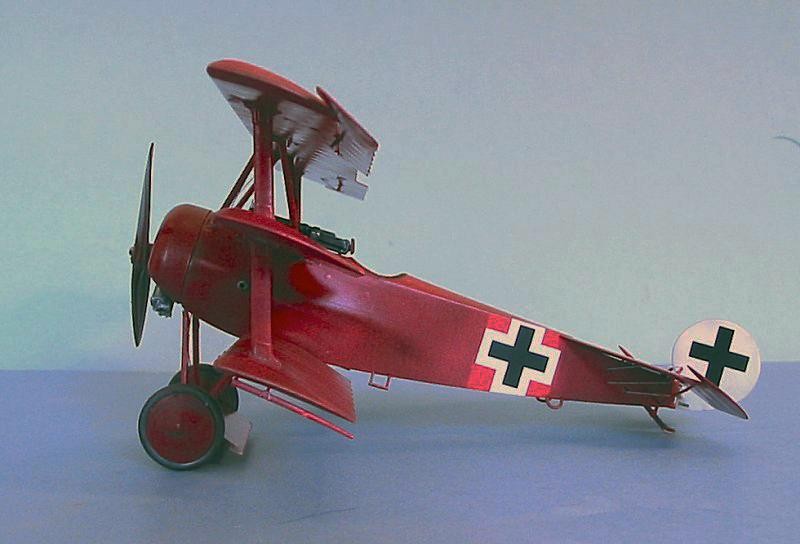
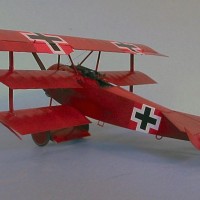
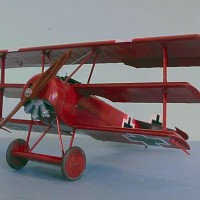

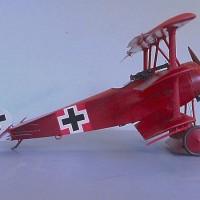
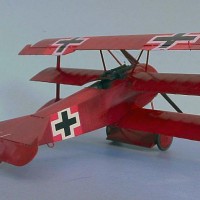
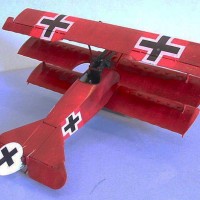
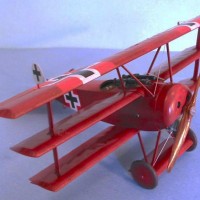


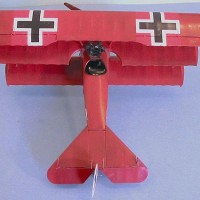
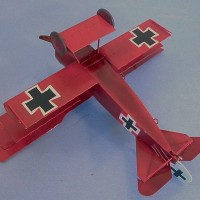
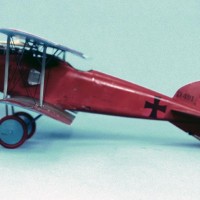
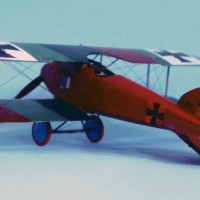
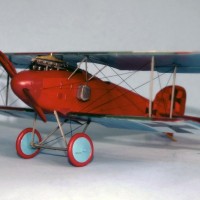
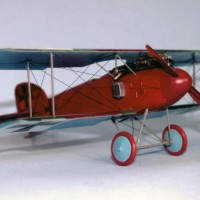
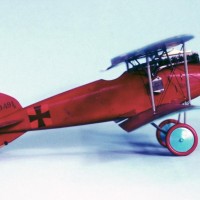
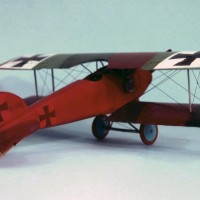
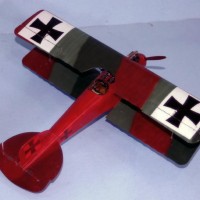

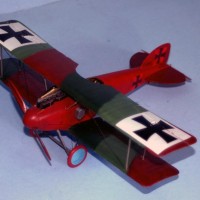
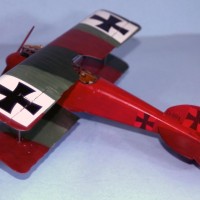
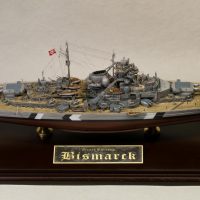
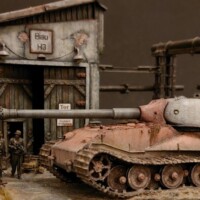


Tom -They're great models, both of them. A detailed and balanced story to go with them. Just my sort of interest. I will always come back to modelling various Fokker Tripes, largely I guess because of MvR's notoriety, So far, I've purposely avoided modelling his final Dr 1 but who knows? Paul
As always, a most interesting background narrative to accompany well done builds.
Thanks for your well written article and for showing us the models Tom!
Best regards
Magnus
Another Cleaver "Classic". There is a short black and white film of Manfred von Richtofen suiting up and climbing into a Dr.I its a little over 40mins. Not all of his planes where painted in red. The film has the standard Fokker finish.
Like the nice touch with the model ...all of the Dr.I s where hand painted. The Red was hand painted and you can see that translucent finish in the model. Most Modelers represent the finish with a solid "Red" sprayed on.
Yeah, he had two other Triplanes with various parts in red, but not all red, at least one Albatros D.V with the metal parts and tail in red and the fuselage unpainted. The Cutting Edge decal sheet for him has the other triplanes on it, if you can find it at a price that doesn't involve rejiggering the national debt.
And yes, nice catch that both of these are painted red over their original finish. Getting the red on the triplane so it covered, but you could still see through it to the streaky camo underneath was hard.
Tom, thanks for clearing that up for me. I always thought that in a lot of cases, the special paint was painted over the stock scheme, ex-works. Unless it was a special aircraft built for a particular person- like Goerings Fokker D-vii overall white bird, not so much.
fine work
Great read, as we've come to expect. I proper the Albatross, just because her shape is so elegant. Brown's account is breathtaking writing; you feel you were there.
Nice! That was the Royal Guardsmen singing Snoopy vs. the Red Baron.